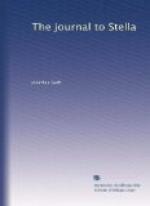31. James Brydges, son of Lord Chandos of Sudeley, was appointed Paymaster-General of Forces Abroad in 17O7. He succeeded his father as Baron Chandos in 1714, and was created Duke of Chandos in 1729. The “princely Chandos” and his house at Canons suggested to Pope the Timon’s villa of the “Epistle to Lord Burlington.” The Duke died in 1744.
32. Charles Talbot, created Duke of Shrewsbury in 1694, was held in great esteem by William iii., and was Lord Chamberlain under Anne. In 1713 he became Lord Lieutenant of Ireland, and held various offices under George I., until his death in 1718. “Before he was o. age,” says Macaulay, “he was allowed to be one of the finest gentlemen and finest scholars of his time.”
33. See No. 23O.
34. William Cavendish, second Duke of Devonshire (1673-1729), who was Lord Steward from 17O7 to 1710 and from 1714 to 1716. Afterwards he was Lord President of the Council. Swift’s comment on Macky’s character of this Whig nobleman was, “A very poor understanding.”
35. John Annesley, fourth Earl of Anglesea, a young nobleman of great promise, had only recently been appointed joint Vice-Treasurer, Receiver-General, and Paymaster of the Forces in Ireland, and sworn of the Privy Council.
36. Nichols, followed by subsequent editors, suggested that “Durham” was a mistake for “St. David’s,” because Dr. George Bull, Bishop of St. David’s, died in 1710. But Dr. Bull died on Feb. 17, 171O, though his successor, Dr. Philip Bisse, was not appointed until November; and Swift was merely repeating a false report of the death of Lord Crewe, Bishop of Durham, which was current on the day on which he wrote. Luttrell says, on Sept. 19, “The Lord Crewe. . . died lately”; but on the 23rd he adds, “The Bishop of Durham is not dead as reported” (Brief Relation, vi. 63O, 633.
37. Lady Elizabeth ("Betty”) Butler, who died unmarried in 175O.
38. Swift wrote in 1734, “Once every year I issued out an edict, commanding that all ladies of wit, sense, merit, and quality, who had an ambition to be acquainted with me, should make the first advances at their peril: which edict, you may believe, was universally obeyed.”
39. Charles, second Earl of Berkeley (1649-171O), married Elizabeth, daughter of Baptist Noel, Viscount Campden. The Earl died on Sept. 24, 171O, and his widow in 1719. Swift, it will be remembered, had been chaplain to Lord Berkeley in Ireland in 1699.
40. Lady Betty and Lady Mary Butler. (see Letter 7, notes 2 and 3.)
41. Henry Boyle, Chancellor of the Exchequer from 17O2 to 17O8, was Secretary of State from 17O8 to 171O, when he was succeeded by St. John. In 1714 he was created Baron Carleton, and he was Lord President from 1721 until his death in 1725.
42. On Sept. 29 Swift wrote that his rooms consisted of the first floor, a dining-room and bed-chamber, at eight shillings a week. On his last visit to England, in 1726, he lodged “next door to the Royal Chair” in Bury Street. Steele lived in the same street from 17O7 to 1712; and Mrs. Vanhomrigh was Swift’s next-door neighbour.




